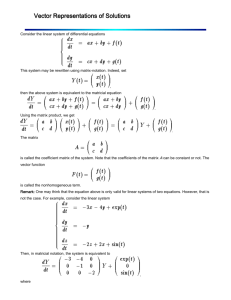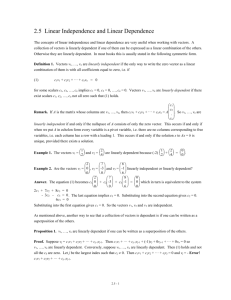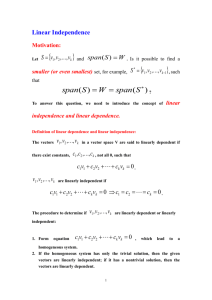vector hence
advertisement
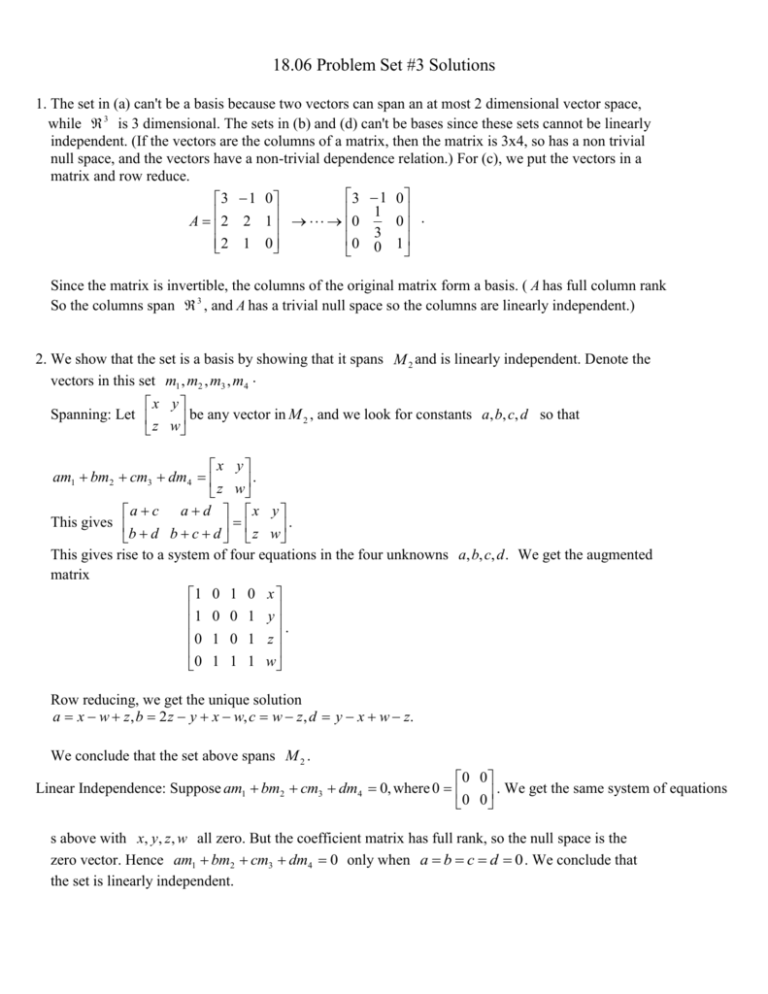
18.06 Problem Set #3 Solutions 1. The set in (a) can't be a basis because two vectors can span an at most 2 dimensional vector space, while 3 is 3 dimensional. The sets in (b) and (d) can't be bases since these sets cannot be linearly independent. (If the vectors are the columns of a matrix, then the matrix is 3x4, so has a non trivial null space, and the vectors have a non-trivial dependence relation.) For (c), we put the vectors in a matrix and row reduce. 3 1 0 3 1 0 1 A 2 2 1 0 0 3 2 1 0 0 0 1 Since the matrix is invertible, the columns of the original matrix form a basis. ( A has full column rank So the columns span 3 , and A has a trivial null space so the columns are linearly independent.) 2. We show that the set is a basis by showing that it spans M 2 and is linearly independent. Denote the vectors in this set m1 , m2 , m3 , m4 x y Spanning: Let be any vector in M 2 , and we look for constants a, b, c, d so that z w x y am1 bm2 cm3 dm4 . z w a c a d x y This gives . b d b c d z w This gives rise to a system of four equations in the four unknowns a, b, c, d . We get the augmented matrix 1 0 1 0 x 1 0 0 1 y . 0 1 0 1 z 0 1 1 1 w Row reducing, we get the unique solution a x w z, b 2 z y x w, c w z, d y x w z. We conclude that the set above spans M 2 . 0 0 Linear Independence: Suppose am1 bm2 cm3 dm4 0, where 0 . We get the same system of equations 0 0 s above with x, y, z , w all zero. But the coefficient matrix has full rank, so the null space is the zero vector. Hence am1 bm2 cm3 dm4 0 only when a b c d 0 . We conclude that the set is linearly independent. 3. (a) We have a, b, c, a b span1,0,0,1, 0,1,0,0, 0,0,1,0, 0,1,0,1 Since the last vector in this set is a linear combination of the other three, we can remove it. The resulting set is a basis, so the dimension is 3. (b) The set a, b, a b, a bis the span of the linearly independent set Hence the dimension is 2. (c) The set a, a, c, d is the span of the linearly independent set Hence the dimension is 3. 1,0,1,1, 0,1,1,1 1,1,0,0, 0,0,1,0, 0,0,0,1 (d) The set a c, a b, b c,a b is the span of the linearly independent set Hence the dimension is 2. 0,1,1,1, 1,0,1,0 4. Row reducing A gives 0 1 2 3 4 0 1 2 0 2 0 1 2 4 6 0 0 0 1 2 0 0 0 1 2 0 0 0 0 0 The rank is 2. A basis for the row space consists of the non-zero rows of the echelon matrix, so Brow 0,1,2,0,2, 0,0,0,1,2 The null space has dimension 5-2 = 3. Assigning the value one or zero to the free variables x1 , x3 , x5 gives our basis Bnull 1,0,0,0,0, 0,2,1,0,0, 0,2,0,2,1 A basis for the column space(which has dimension 2) is given by the columns of the original matrix that correspond to pivot columns in the echelon matrix. Hence Bcol 1,1,0, 3,4,1 Finally, for the left nullspace, N AT , we can use the fact that N AT is the orthogonal complement of the column space in 3 . It's easy to see that the (one dimensional) space of vectors orthogonal to the column space of A has basis BN AT 1,1,1 5. We show that this set spans n and is linearly independent. Since A is invertible, given any vector b in R n ,there is exactly one vector x in n with Ax b. but x can be written as a linear combination of the basis vectors v1 ,...vn . That is, x c1v1 ... cn vn for some constants c1 ,.., cn . But then we have b Ax Ac1v1 ... cn vn c1 Av1 ...cn Avn . Hence, we have written b as a linear combination of the vectors Av1 ,... Avn . Since b was an arbitrary vector in n ,The set Av1 ,..., Avn spans R n Now, suppose that there are constants d1 ,...d n so that d1 Av1 ... d n Avn 0. Then 0 d1 Av1 ... d n Avn Ad1v1 ... d n vn . Since A is invertible, it has trivial nullspace, and we conclude that d1v1 ... d n vn 0. But the set v1 ,...vn is linearly independent, so we must have d1 d 2 ... d n 0. But that says that if d1 Av1 ... d n Avn 0 then all the constants are zero. That is, the set Av1 ,..., Avn is linearly independent. Since this set is a linearly independent spanning set in n , it is a basis.
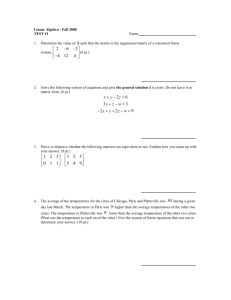

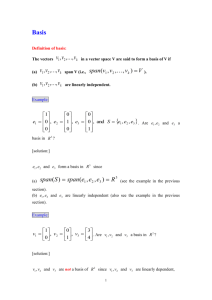
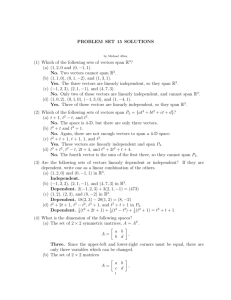
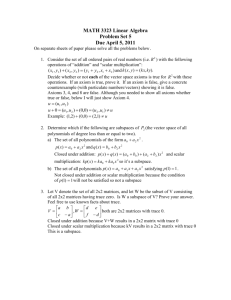

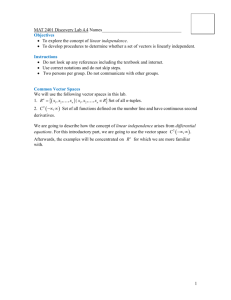
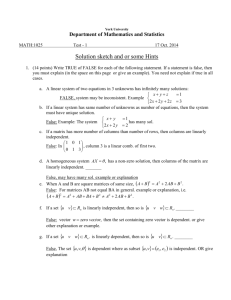
![2010Fall-LA-Lecture-13[1]](http://s3.studylib.net/store/data/006762182_1-3901e79b726aad1cc0b426785aced7c7-300x300.png)
